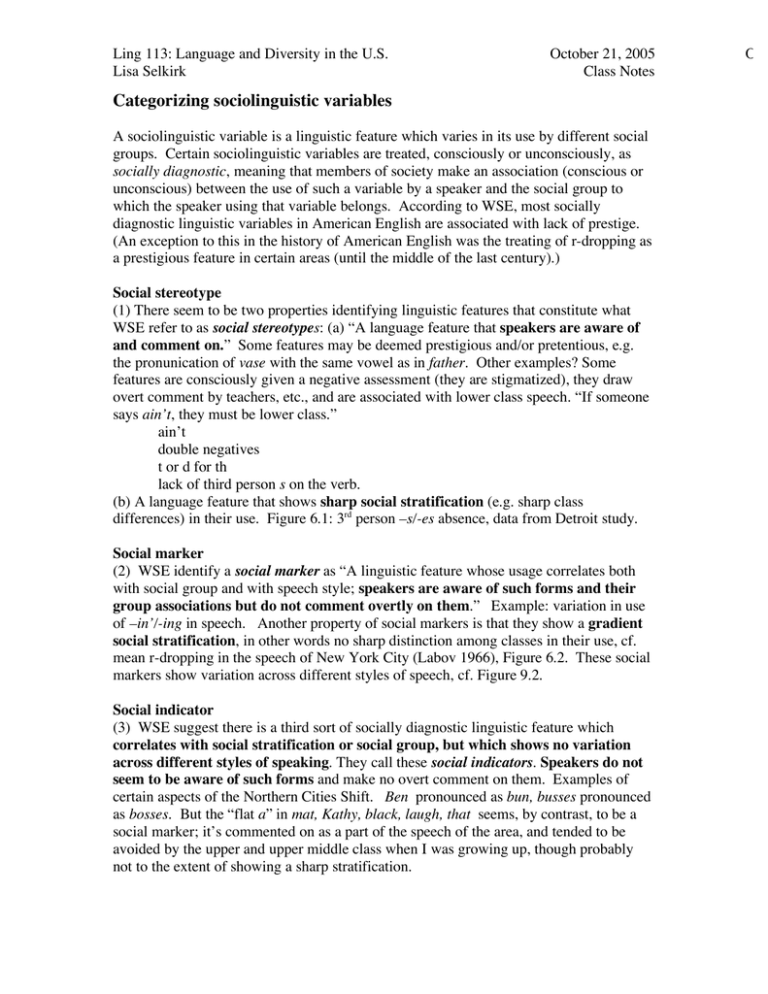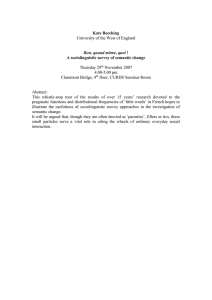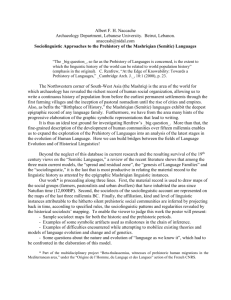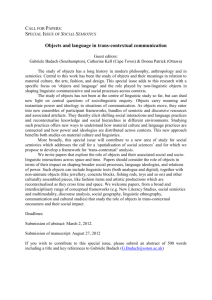Categorizing sociolinguistic variables
advertisement

Ling 113: Language and Diversity in the U.S. Lisa Selkirk October 21, 2005 Class Notes Categorizing sociolinguistic variables A sociolinguistic variable is a linguistic feature which varies in its use by different social groups. Certain sociolinguistic variables are treated, consciously or unconsciously, as socially diagnostic, meaning that members of society make an association (conscious or unconscious) between the use of such a variable by a speaker and the social group to which the speaker using that variable belongs. According to WSE, most socially diagnostic linguistic variables in American English are associated with lack of prestige. (An exception to this in the history of American English was the treating of r-dropping as a prestigious feature in certain areas (until the middle of the last century).) Social stereotype (1) There seem to be two properties identifying linguistic features that constitute what WSE refer to as social stereotypes: (a) “A language feature that speakers are aware of and comment on.” Some features may be deemed prestigious and/or pretentious, e.g. the pronunication of vase with the same vowel as in father. Other examples? Some features are consciously given a negative assessment (they are stigmatized), they draw overt comment by teachers, etc., and are associated with lower class speech. “If someone says ain’t, they must be lower class.” ain’t double negatives t or d for th lack of third person s on the verb. (b) A language feature that shows sharp social stratification (e.g. sharp class differences) in their use. Figure 6.1: 3rd person –s/-es absence, data from Detroit study. Social marker (2) WSE identify a social marker as “A linguistic feature whose usage correlates both with social group and with speech style; speakers are aware of such forms and their group associations but do not comment overtly on them.” Example: variation in use of –in’/-ing in speech. Another property of social markers is that they show a gradient social stratification, in other words no sharp distinction among classes in their use, cf. mean r-dropping in the speech of New York City (Labov 1966), Figure 6.2. These social markers show variation across different styles of speech, cf. Figure 9.2. Social indicator (3) WSE suggest there is a third sort of socially diagnostic linguistic feature which correlates with social stratification or social group, but which shows no variation across different styles of speaking. They call these social indicators. Speakers do not seem to be aware of such forms and make no overt comment on them. Examples of certain aspects of the Northern Cities Shift. Ben pronounced as bun, busses pronounced as bosses. But the “flat a” in mat, Kathy, black, laugh, that seems, by contrast, to be a social marker; it’s commented on as a part of the speech of the area, and tended to be avoided by the upper and upper middle class when I was growing up, though probably not to the extent of showing a sharp stratification. Octo Ling 113: Language and Diversity in the U.S. Lisa Selkirk October 21, 2005 Class Notes QUESTIONS: What sort of sociolinguistic variable is r-dropping in Massachusetts? Is it a social stereotype, a social marker or a social indicator, according to these criteria? Do we have the evidence that would allow us to answer this? What evidence would we need? What explains the relation between the overt awareness and assessment of a sociolinguistic variable and the pattern of its use (sharp/gradual social stratification, change in use with speech style)? What sorts of social characteristics of individuals correlate with the use of linguistic variables? Octo







